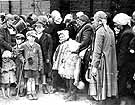 The Destruction of Hungarian Jews
The Destruction of Hungarian Jews
"I was born in May. I died in May," Isabella Leitner writes in a Holocaust memoir called Fragments of Isabella. "We started the journey of ugliness on May 29th. We headed for Auschwitz. We arrived on May 31st." Even in early 1944, Hungary's 725,000 Jews seemed to be relatively safe. The leaders of this last great European Jewish community had reports about the fate of Jews under Nazi occupation, and Hungarian Jewry did live in a precarious situation given that country's alliance with Hitler. But compared to the situation of other Jewish communities, most of which had been annihilated by 1944, Hungarian Jews seemed fortunate. Indeed, until March 19, 1944, when the Germans occupied the territory of their faltering ally, many of Hungary's Jews suffered from what writer Ida Fink, another Holocaust survivor, called "the poverty of imagination." They did not believe that what had happened to the Jews in Nazi-occupied Europe would happen to them. Nevertheless, the nightmare began in April 1944. First Hungarian Jews were ghettoized, and then on April 29-30 two transports, carrying a total of 3800 men and women, departed Hungary. They reached Auschwitz on May 2. The "selection" spared 486 men and 616 women for labor. The remaining 2698 were gassed. By mid-July 147 trains had deported more than 430,000 Hungarian Jews to Auschwitz. More than 75 percent were killed on arrival. Before Hungary's liberation in early 1945, more than 560,000 Hungarian Jews were dead. Isabella Leitner's 20th birthday was on Sunday, May 28, 1944. Her "celebration" included preparation for the next day's deportation. That journey took Leitner, her four sisters, her brother, and her mother--along with hundreds of other Hungarian Jews--from the ghetto at Kisvárda to Auschwitz. Her mother and youngest sister were killed on arrival. Another sister perished in Bergen-Belsen, but Isabella and her other siblings survived. Eventually she was reunited with her father, too. In desperation he had gone to the United States in an effort to save his family by obtaining visas for them. He was spared the Nazi horrors, but for the rest of his life he felt that he had not done enough to save his family. After her liberation and arrival in the United States, Leitner was unable to leave behind her "other life" in the ghetto, on the train, in the camps. "You have one vision of life," she says during an oral history interview, "and I have two." Speaking for many Holocaust survivors, she adds that "we have these...these double lives. We can't cancel out. It just won't go away...it's very hard."
Photo: Yad Vashem / United States Holocaust Memorial Museum Photo Archive
|
